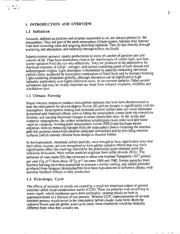
NASA Technical Reports Server (NTRS) 20010057626: Atmospheric Aerosols PDF
Preview NASA Technical Reports Server (NTRS) 20010057626: Atmospheric Aerosols
2 1. INTRODUCTION AND OVERVIEW 1.1 Definition Aerosols, defined as particles and droplets suspended in air, are always present in the atmosphere. They are part of the earth-atmosphere climate system, because they interact with both incoming solar and outgoing terrestrial radiation. They do this directly through scattering and absorption, and indirectly through effects on clouds. Submicrometer aerosols usually predominate in terms of number of particles per unit volume of air. They have dimensions close to the wavelengths of visible light, and thus scatter radiation from the sun very effectively. They are produced in the atmosphere by chemical reactions of sulfur-, nitrogen- and carbon-containing gases of both natural and anthropogenic origins. Light absorption is dominated by particles containing elemental carbon (soot), produced by incomplete combustion of fossil fuels and by biomass burning. Light-scattering dominates globally, although absorption can be significant at high latitudes, particularly over highly reflective snow- or ice-covered surfaces. Other aerosol substances that may be locally important are those from volcanic eruptions, wildfires and windblown dust. 1.2 Climate Forcing Major volcanic eruptions produce stratospheric aerosols that have been demonstrated to heat the stratosphere by several degrees Kelvin (K) and are thought to significantly cool the troposphere. Stratospheric heating and increased aerosol surface area can cause important dynamical and chemical effects, such as lifting the stratospheric ozone layer via convective motions, and causing important changes in ozone destruction rates. In the Arctic and Antarctic stratospheres, the coldest wintertime temperatures cause nitric acid and water vapor to condense, forming polar stratospheric clouds (PSCs) that facifitate ozone depletion, both by removing nitrogen from the stratosphere (hence curtailing the reaction path that protects ozone from chlorine-catalyzed destruction) and by providing reaction surfaces (which convert chlorine from benign to reactive forms). In the troposphere, manmade sulfate particles, once thought to have significance only near their urban sources, are now recognized to have global radiative effects that may have significantly offset the warming induced by the greenhouse gases released since the industrial revolution. Most sulfate particles originate from sulfur dioxide (SO2). The emission of man-made SO2 has increased to about one hundred Taragrams (1012 grams) per year (Tg yr-1) from about 10 Tg yr-I between 1880 and 1980. Smoke particles from biomass burning have been postulated to produce a similar cooling, and sulfate particles produced from biogenic dimethylsulfide have been hypothesized to influence albedo, with possible feedback effects on their production. 1.3 Hydrologic. Cycle The effects of aerosols on clouds are caused by a small but important subset of aerosol particles called cloud condensation nuclei (CCN). These are particles with an affinity to water vapor, which condenses upon them preferably, causing clouds to form at super'saturations of a fraction of one percent : Without CCN, supersaturation of several hundred percent would occur in the atmosphere before clouds could form. Both the radiative fluxes and the global water cycle under those conditions would be critically different from what they actually are. Theconcentrations,izeandwatersolubilityofCCNhaveanimmediateinfluenceonthe concentrationandsizeofclouddropletswhich,inturn,determinestheradiativeproperties ofclouds.Physical(coagulation)andchemical(surfaceadsorptionofgases)interactions betweennaturalandman-madesubstancecsaninfluencethecloud-formingability of aerosolst,herebyaffectingthefrequencyofformation,lifetime,andradiativepropertiesof clouds.At constantwatervapormixingratiosandtemperaturein, creasedconcentrationsof CCNresultinincreasednumberofclouddropletsofsmallersize,therebyenhancingthe shortwavealbedoofclouds.Anthropogenicsulfateaerosolsandsmokesfrom biomass burningappeartodominateman-madealbedoincreasesofclouds.Incontrast,soot particlesincorporatedin sufficientamountsintoclouddropletscanreducecloudalbedo. An increaseincloud-dropletconcentrationduetodecreasein meandropletsizeisalso expectedtoinhibitgrowthtoprecipitationparticlesizesandthusextendcloud lifetimes. Theresultantincreaseinfractionalcloudcoverwouldaffectradiationtransferthroughthe atmosphereI.nhibitedprecipitationdevelopmenctouldfurtheraltertheamountand distributionofwatervaporandheatintheatmospherea,ndtherebymodifytheearth's hydrologicalcycle.Changesinglobalweatherpatternsaswellasintheconcentrationof watervapor,adominantgreenhousgeas,couldbetheconsequence. 1.4 Relevant Aerosol Characteristics Aerosol characteristics that determine environmental effects are physical (size, shape, number), chemical (composition) and optical (refractive index) properties. These properties are difficult to assess for a variety of reasons, one of which is that aerosol concentrations vary strongly in space and time. This is due to the fact that atmospheric residence times are shorter than mixing times within each hemisphere, which are still shorter than mixing times between hemispheres. As a consequence, measurements made at any given time and place are not necessarily typical for other times and locations. Satellites that could provide adequate global and temporal coverages currently have too limited a capability for delineating relevant aerosol characteristics, and aircraft and ground measurements are too spotty in space and time to adequately determine the global distributions of aerosols. In addition, aerosols cover several orders of magnitude in concentration (from less than one, to several millions per cubic centimeter) and size (from units of Angstroms for molecular clusters to millimeters of precipitation particles). No one single instrument or technique adequately assesses atmospheric aerosol properties over this entire size range. Finally, in contrast to trace gases, concentration of aerosol particles is sparse such that measurements have significant experimental and statistical uncertainties. What follows is an overview of man-made aerosols in relation to the natural atmospheric background aerosol, considering (1) formation, evolution, transport and fate of tropospheric and stratospheric aerosols; (2) effects on climate; and (3) role in heterogeneous chemistry, including polar stratospheric clouds. 2. FORMATION, TRANSFORMATION AND REMOVAL 2.1 Primary and Secondary Aerosols Atmospheric aerosols may, according to Whitby (1978), be either primary and secondary. If primary, they are due to direct emission of particulate material into the atmosphere, from both anthropogenic (e.g., urban/industrial processes, land use practices) and natural activities (e.g., volcanism, windblown dust, sea-spray). Secondary aerosols result from particle formation by gas reactions.
